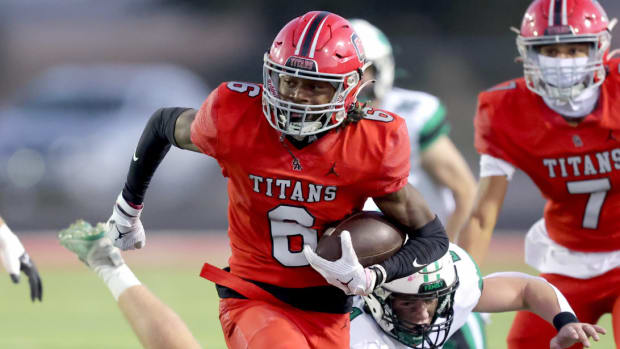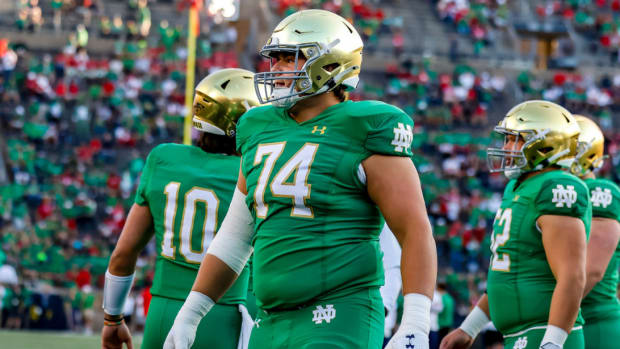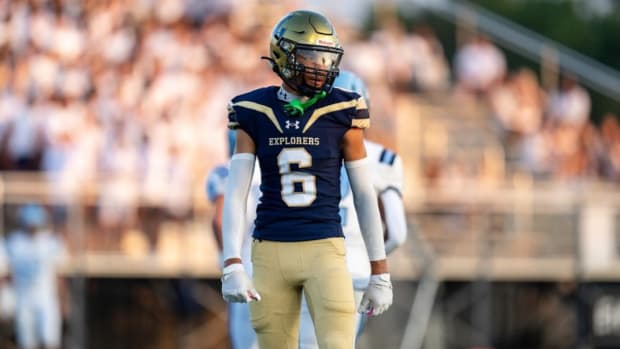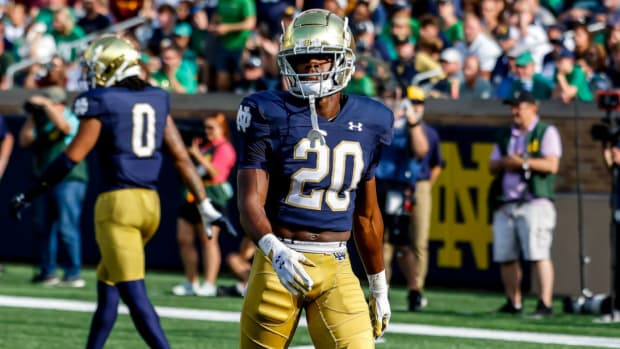Notre Dame And The Big Ten - Part IV: The Past Shaping The Future
Looking back at the history of Notre Dame and the Big Ten, it is easy to come to the conclusion that the best things to ever happen to the football program – and the university – were the multiple rejections by the Big Ten in the early years of the 20th century.
Excluded, and at times boycotted by Big Ten schools, Notre Dame was forced to sink or swim, and in finding its own independent way achieved national success and international recognition. Independence became part of the soul of the university, as the Board of Trustees affirmed in 1999, and subsequent university and athletic department decisions in the two decades since then have been designed to protect that independence.
Despite the jealousy of other fan bases and the lazy narrative pushed by the national media, Notre Dame is incredibly well positioned to remain independent in the future – and should.
As an independent, the only title that Notre Dame can ever play for is a national title. While 2020 was a unique exception, and one that allows Notre Dame fans to point out that the independent Irish have played for more conference titles than Jim Harbaugh has in six seasons at Michigan, the goal every season at Notre Dame is to win a national title. In fact, Michigan has yet to play in any of the 10 Big Ten Championship games to be played thus far.
Be sure to check out the Irish Breakdown message board, the Champions Lounge
In both the BCS and the College Football Playoff, Notre Dame has never been slighted by the computers or the committee for not playing in a conference championship game, despite the howls of talking heads around the country referencing a “13th data point”. These pundits happily ignore the fact the “extra” game other programs play that makes their schedule “so much tougher” is a tune up against the likes of Furman, Tennessee Tech, something called “Houston Baptist”, or Midwest Directional School U.
In contrast, I’m sure Brian Kelly would have preferred not to end the undefeated 2018 regular season by flying twice across the country to play in San Diego, Chicago, South Bend, New York City, and Los Angeles the last five weeks in succession, but that is the challenge that Notre Dame’s supposedly “easy” schedule presents.
College Football playoff expansion is inevitable in the next couple years, but Notre Dame Director of Athletics Jack Swarbrick has done a great job improving the Irish’s access to the playoff, though at the expense of a longer road to the championship. Swarbrick was a member of the committee that studied playoff expansion in spring 2021, and to once and for all end the clamoring about a 13th data point, Swarbrick traded the ability of an independent Notre Dame to be a top-4 seed for the fact that an Irish team ranked in the top-4 will get to host a home playoff game in South Bend (assuming Notre Dame earns a 5-8 seed).
This means that Notre Dame will always have played the same number of games as the top four conference champions heading into the quarterfinals. Though the fact that the top 4 teams can only be conference champions is short-sighted and doesn’t just hurt Notre Dame (let’s just wait for a previously undefeated and top-ranked SEC team to get upset in the SEC championship and fall to fifth), at the end of the day, there are now 6 at-large spots up for grabs, as opposed to just 4 under the current system. Ultimately, Swarbrick maintained independence while increasing access, and now the product on the field needs to improve to win 4 games in a row against top competition.
Like access to compete for a title is necessary to maintain football independence, access to a conference to call home for other sports is also required. Other Notre Dame athletic programs had also competed as independents for much of their history – notably basketball – but those programs started to lose relevance given the conference-centric nature of many of the non-revenue sports.
Be sure to check out the Irish Breakdown message board, the Champions Lounge
The university made the decision to join the expanded Big East Conference for all sports other than football in 1995, which was a welcome move according to then basketball coach John MacLeod, who stated “I can tell you that we did lose players we really wanted because of our independent status.”
The key for the successful partnership with the Big East until 2013, and the ACC since then (with the exception of hockey which joined the seven team Big Ten in 2017), has been that those conferences allow the Irish to compete in all sports other than football. This was the key driver in joining the ACC in 2013, as Swarbrick said “We are able to maintain our historic independence in football, join the ACC’s non-BCS bowl package, and provide a new and extremely competitive home for our other sports.”
ACC membership has been a great benefit for Notre Dame, as the women’s basketball team claimed a national title and other sports such as lacrosse, baseball and (for a time) men’s basketball have risen to even greater national prominence. At the same time, in addition to finding a conference home for the pandemic-impacted 2020 season, the ACC football scheduling agreement has allowed the Irish to play in Florida, Georgia, South Carolina, North Carolina, and Virginia – expanding the football program’s presence in those growing states, which has already paid off on the recruiting trail – while also renewing rivalries with Florida State and Miami and building new ones with Clemson and Virginia Tech.
With access to compete for a football national championship seemingly protected and conference membership for all sports other than football in place, Notre Dame is well-positioned to continue its football independence into the future. Furthermore, football independence puts the Irish in an incredible spot to take advantage of the recent NIL rulings and use that as the catalyst to close the gap with Alabama, Clemson and Ohio State.
As Irish Breakdown has covered numerous times, Notre Dame is already very close to truly challenging those programs, and just needs a couple more top-ranked recruits each year to get there. NIL provides the vehicle to do that and brings us full circle in this series. The Big Ten’s rejections of Notre Dame in the early 1900s forced the Irish to become a national program and embedded independence into the soul of the university, which is manifested on fall Saturdays by the football team.
Now, with athletes able to profit off their name, image, and likeness, Notre Dame can and must leverage the national brand it built to the fullest. Despite the proliferation of television rights, college football’s conference model means the sport is still largely a regional game – but Notre Dame is not constrained by a conference, thanks to the Big Ten. There is no excuse for why in a world with NIL in place, Notre Dame is not regularly signing one of the top 2-3 quarterbacks in the country each cycle, because as noteworthy as Trevor Lawrence, Joe Burrow, Justin Fields, and many other recent top QBs have been, their brand would go to the next level at Notre Dame.
For instance, just look at the attention that Manti Te’o’s story received nationally (at first for better, then for worse), and then consider the fact that he played middle linebacker, not quarterback. Te’o – even before the catfishing incident – was indisputably more well-known nationally than any of the aforementioned quarterbacks and was the most famous college football player in the country in 2012. For those still skeptical, who won the Heisman in 2012?
How many of you remembered it was Johnny Manziel, even as famous as Manziel was that season? Te’o finished second, with Collin Klein of Kansas State third, Marqise Lee of USC fourth, and Braxton Miller of Ohio State fifth.
The good news is that the coaching staff and university administrators appear aligned, and if the feedback from the June visits is any indication, are knocking things out of the park around NIL compared to other schools. University president Fr. John Jenkins went on the record in a New York Times editorial last week staking out support for NIL legislation and calling for other athlete-centered reforms, such as guaranteed four-year scholarships and the extension of health insurance for injured athletes after graduation.
Additionally, the football program has presented recruits with cutting-edge ideas on how athletes can take advantage of NIL during the June official visits (based on feedback from parents), and has gone on the offensive placing billboards promoting Notre Dame players and coaches in Georgia, North Carolina, New Jersey, Kentucky, Ohio, California, Pennsylvania, Missouri, Florida, Michigan, Arizona, Virginia, and Indiana, which truly emphasizes the national reach of the program.
Be sure to check out the Irish Breakdown message board, the Champions Lounge
At Notre Dame, the question always comes back to championships, and one of the main arguments in favor of Notre Dame relinquishing football independence was that conference membership would give the Irish the ability to compete for a conference title as a secondary goal, and also would allow Notre Dame to make the College Football Playoff as a one loss team. However, with NIL in place and playoff access soon to be expanded, conference membership would nullify the main element that makes Notre Dame unique – its independence.
While schools such as Alabama, Ohio State and Clemson can offer recruits on-field success and a direct path to the NFL, and other universities like Stanford, Cal, Northwestern and Duke offer a world-class education, Notre Dame is the only university in the country that can offer both of those things to a recruit, while also giving a recruit access to the marketing and branding opportunities that the most famous college football program in the country can provide.
This will not be like the Lou Holtz years when Notre Dame seemingly signed every Parade All-American, but it does not need to be. Kelly and the coaching staff deserve immense credit for building the program back to where a 9 or 10 win season is considered the floor, and all that needs to occur is for Notre Dame to sign one or two more top-ranked recruits per cycle they otherwise would not get, especially at the quarterback position, and that is achievable with NIL in place. Should that occur, it will not matter that the Irish are the 5-seed in the playoffs as the team will be well-equipped to travel the longer road through the playoff to a title.
Therefore, in the end, the Big Ten’s rejection of Notre Dame in the early 1900s continues to be the gift that keeps on giving. Big Ten member schools, especially Michigan, thought that rejection and boycott would teach the small Catholic school a lesson and put it in its place. Instead, their actions did just the opposite.
In addition to the Irish claiming 10 national championships after the final Big Ten rejection in 1926, losses (or ties) to Notre Dame teams in some of college football’s most famous games denied the Big Ten schools the chance at multiple championships, most notably at Michigan where Bo Schembechler lost 5 times to Notre Dame (in 11 years no less) when he had a team ranked in the top 10. The examination of the benefits of Big Ten membership in the 1990s offered Notre Dame a chance to reflect on what independence meant to the university, an effort which resulted in a public declaration that independence was essential to the Notre Dame spirit and could not be bought by millions more in media rights deals.
Decisions since then have focused on protecting football independence, from backing an expanded playoff model to finding a stable conference home for other sports. Now, as college football moves into the NIL era, independence – and the resulting national brand that accompanies it – allows Notre Dame to offer recruits opportunities that no other school can, which if properly harnessed will allow Notre Dame to close the gap with Alabama, Clemson and Ohio State, cement its place among the top 4 programs in the country, and win another national title.
To read part one of this series click HERE. To read part two of the series click HERE. To read part three of the series click HERE.
Be sure to check out the Irish Breakdown message board, the Champions Lounge
Irish Breakdown Content
Notre Dame 2021 Roster
Notre Dame 2021 Schedule
Notre Dame 2022 Commits Big Board: Offense
Notre Dame 2022 Commits Big Board: Defense
2022 Big Board: Running Back
2022 Big Board: Slot Receivers
Notre Dame 2022 Scholarship Offers
Notre Dame 2022 Class Big Board
Notre Dame 2023 Class Big Board
———————
Become a premium Irish Breakdown member, which grants you access to all of our premium content, our premium message board and gets you a FREE subscription to Sports Illustrated! Click on the link below for more
Be sure to stay locked into Irish Breakdown all the time!
Join the Irish Breakdown community!
Subscribe to the Irish Breakdown YouTube channel
Subscribe to the Irish Breakdown podcast on iTunes
Subscribe to our Irish Breakdown Rumble channel
Follow me on Twitter: @CoachD178
Follow me on Parler: @BryanDriskell
Like and follow Irish Breakdown on Facebook




